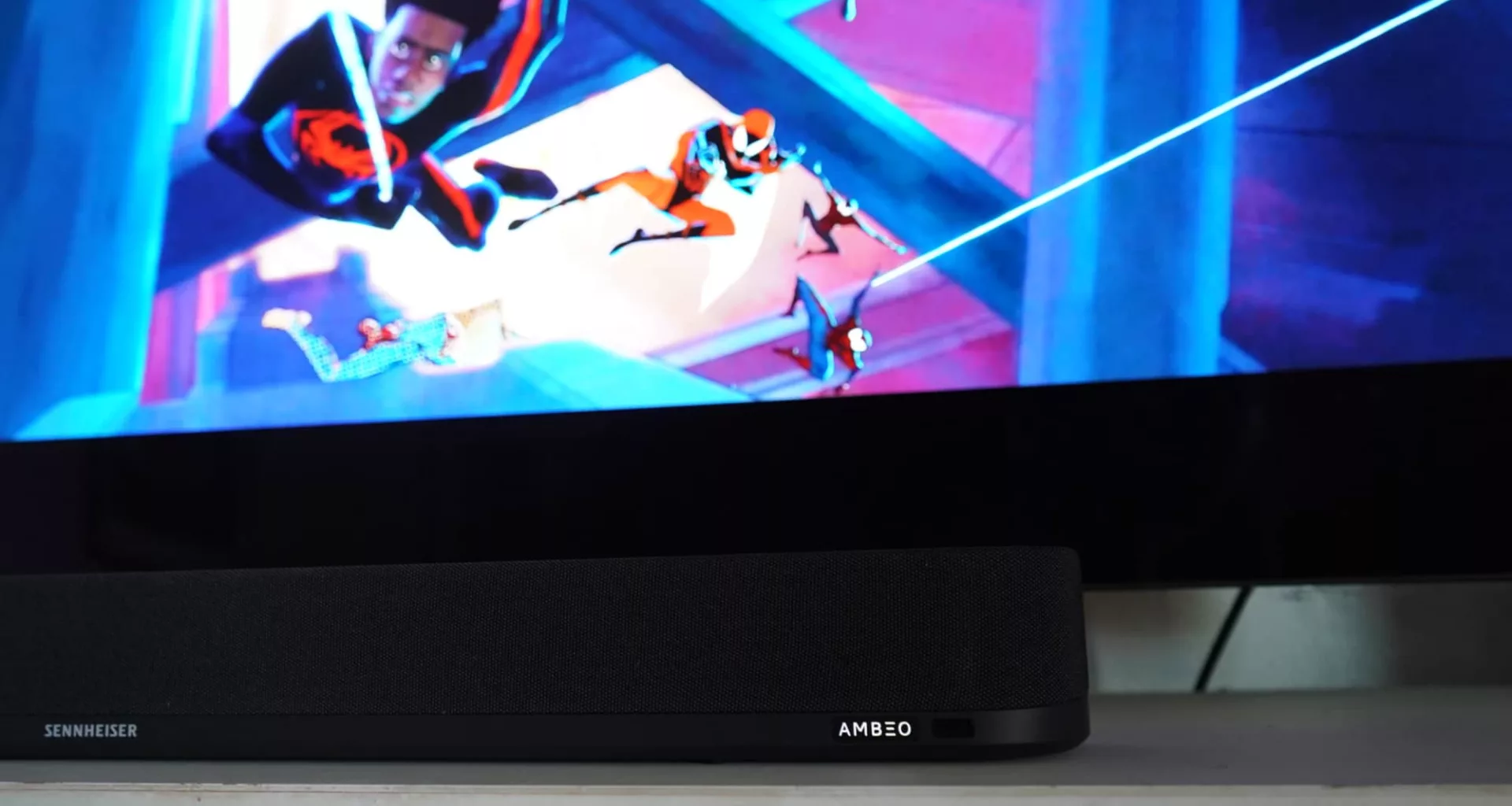Quick review
The good
The not-so-good
At over a thousand dollars, Sennheiser’s Ambeo Mini is much less expensive than the standard $4K Ambeo. But given what it competes against in soundbars, it still might be too much.
Great home theatre sound has never been in reach of as many people as it is now, and all without spending quite the amount you used to need to. While a proper movie and music experience at home used to be the domain of several thousand dollars worth of amps, receivers, and speakers, these days, you can simply patch it in with a mere soundbar upgrade.
In one move, you can transform a TV speaker system to something more deserving of the films you watch, delivering an all-encompassing sound. Several speakers encased in the one and support for high-end audio formats like Dolby Atmos and DTS:X are the norm, and all from a device typically shorter than the length of the TV you’re watching it all on.
Better sound is within reach of any TV owner, and they won’t need to call up a sparky to install special speakers to make it happen.
That’s been the case for a number of years, and the latest soundbars promise even more. Dimensional sound from a compact body has been the target for the past couple of years, and we’re seeing more of it than ever lately.
In Sennheiser’s Ambeo Mini, one of the longest established sound brands is aiming to do just that in a soundbar that costs a little over a grand. Does it succeed, or is your money spent better elsewhere?
Design and features

This isn’t the first time Sennheiser has done the dance with an Ambeo speaker. We saw one a few years ago, and it more or less heralded the arrival of 3D sound at home.
The staggering size and price of the Ambeo may not have been to everyone’s liking, but the performance delivered, and gave us a heads up on what the name “Ambeo” would mean: 3D spatial sound.
By comparison, the Ambeo Mini isn’t quite the same model. Its difference is clear, not just in the name, as the Mini cuts the size and price considerably.
A compact speaker with a soft fabric grille, it’s fairly minimalistic and easy on the eyes, while including some solid tech on the inside.
Six speakers can be found on the inside, covering four 1.6 inch drivers and two 4 inch woofers, powered by six Class D amps. The hardware covers front, left, right, and sub channels, and while the Ambeo Mini is billed as a spatial speaker, the spatial approach here is a psychoacoustic one, so no upfiring speakers, it seems. Sit the right way on your couch and you’ll hear it.
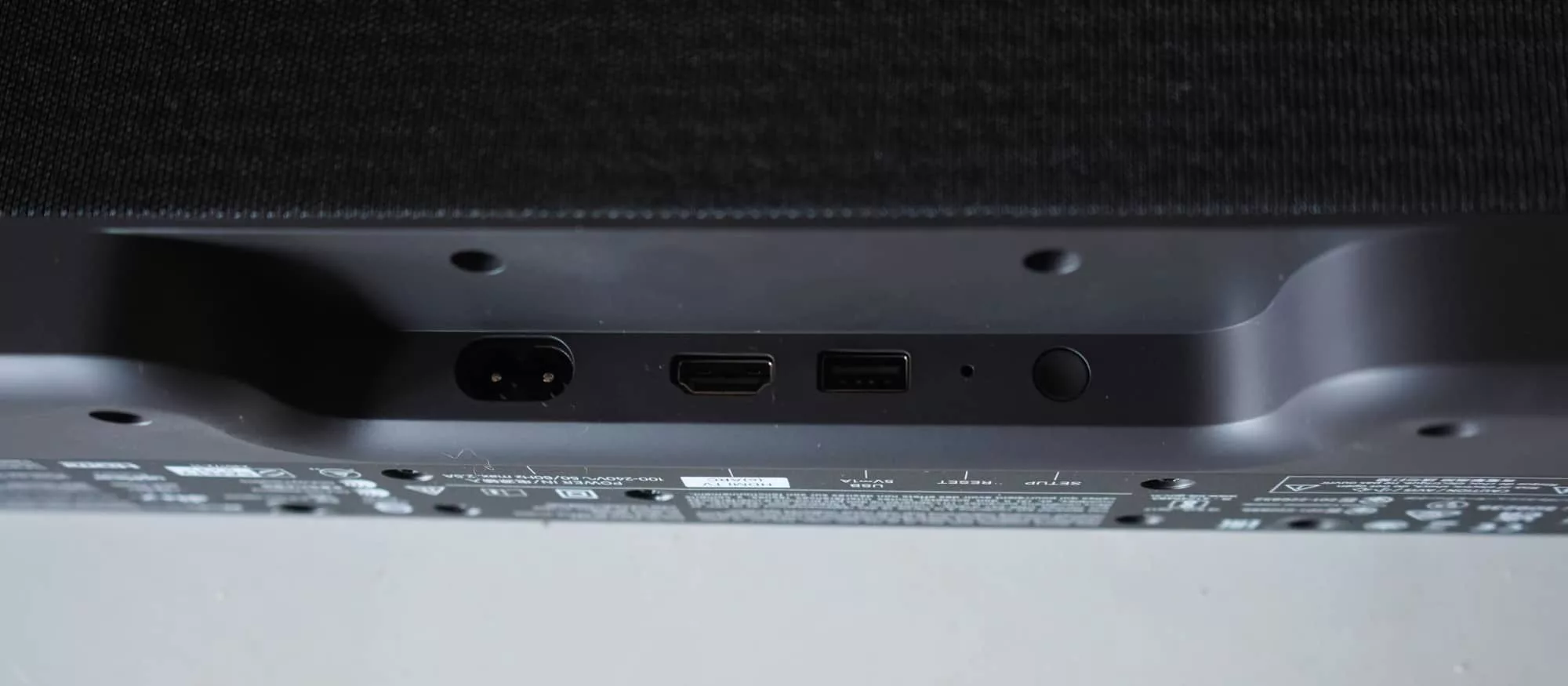
There’s a good 250 watts of power in the Ambeo Mini and support HDMI, WiFi 6, and Bluetooth, with an extra USB port, too.
The Ambeo Mini can be controlled and setup using the app, which is available for iOS and Android, and is also the same app normally used for Sennheiser’s headphones.
In-use
An app is important here because like so many other sound devices these days, there’s no remote. Your phone is your remote, or your tablet, because the app can work on either.
Grab your phone and set the system up, bringing it to life by connecting it to your WiFi. That setup procedure will introduce you to some of the Ambeo Mini’s features, including support for Chromecast, Spotify Connect, and a quick microphone-based room calibration which does the regular trick of firing sound out and listening to what it sounds like in your room to tweak the delivery accordingly.
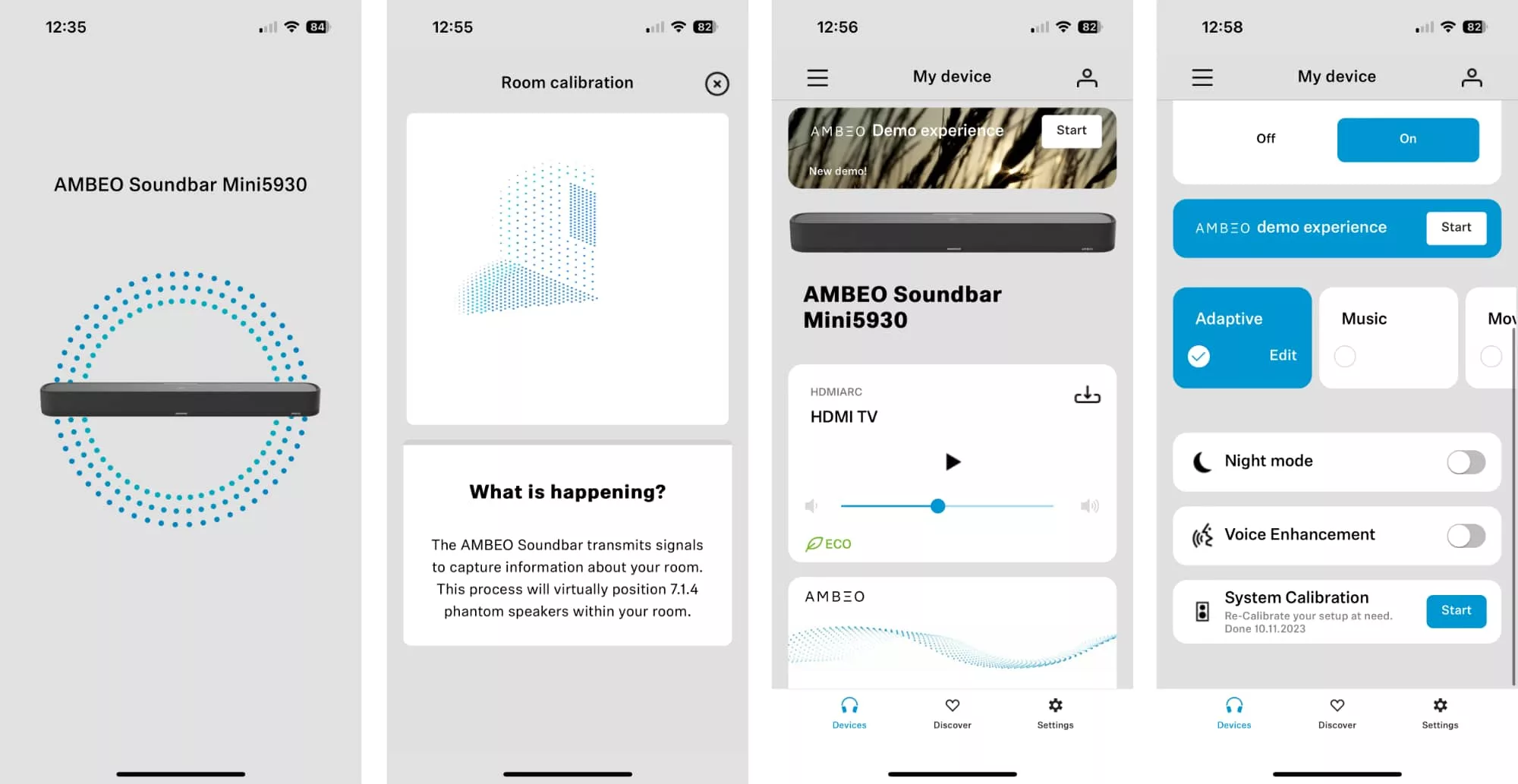
The app also lets you turn features on and off with ease, such as the Ambeo 3D spatial mode, and you can tweak the equaliser if need be, and there are some on-device controls, as well.
If you don’t have a lot of 3D sound to test with — and you probably do, provided you pay for the premium streaming services — Sennheiser has included a few 3D sound tests that can be triggered inside the app, giving you a taste of what’s to come.
Alternatively, you can just keep reading, because we’re taking that for a spin next in our Ambeo Mini review below.
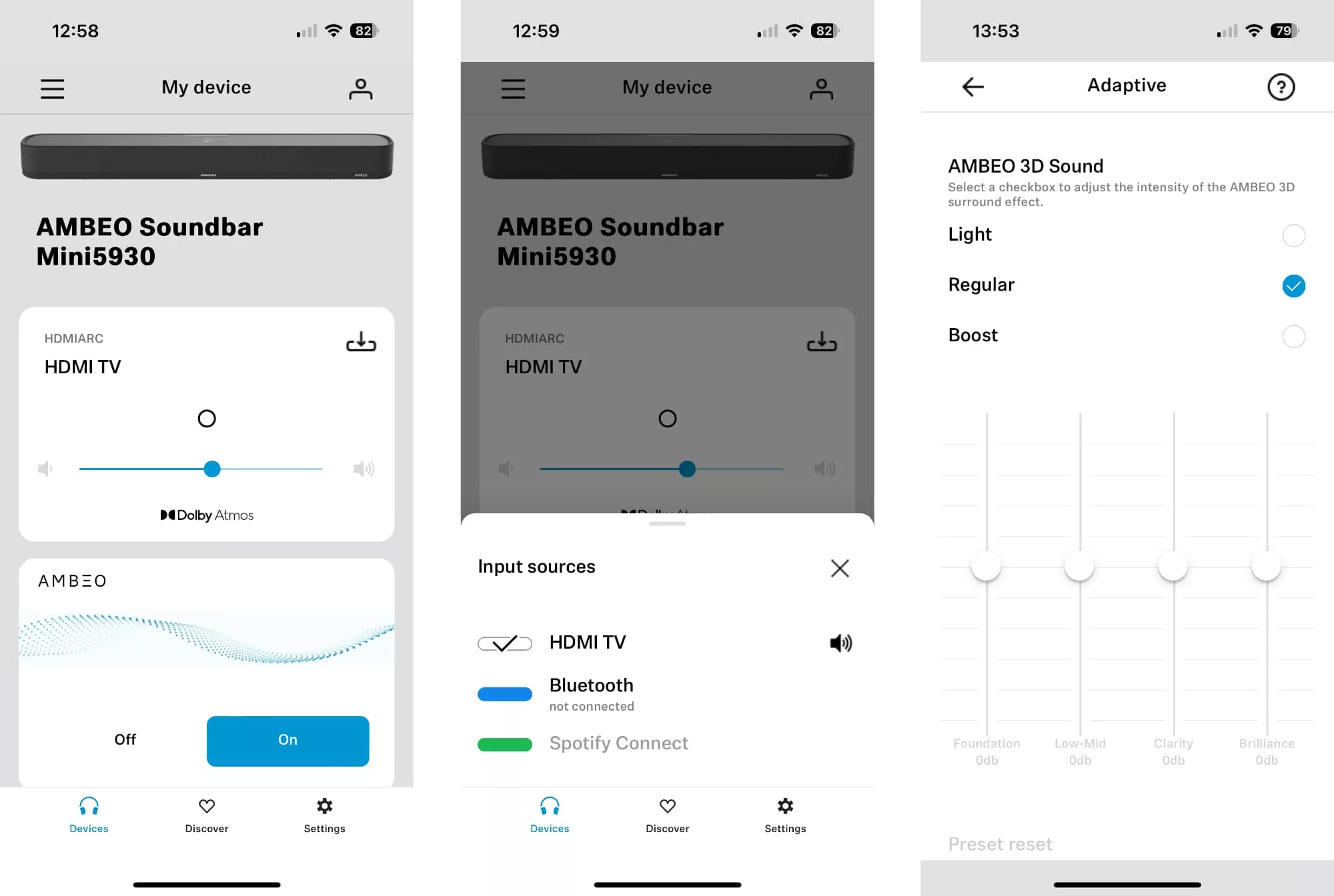
Performance
Testing the performance of the Ambeo Mini is understandably the most critical part, because you’re hardly going to buy this soundbar to look good under your TV.
We’ve divided this into two sections, covering movies and music, because they’re the most likely uses for the Ambeo Mini. Granted, you could use it for anything — podcasts, annoying your neighbours with a near permanent Rickroll or dog noises — but movies and music are the most likely culprits.
Ahead of this performance test (which you can test using our music and movie playlists), we can note something: wooo this thing gets loud. Even at around the third volume mark on the Ambeo Mini, there was plenty of sound coming out, enough to keep even ardent audio-obsessed individuals like us happy. It has so much sound, you won’t expect it from such a small size.
Movies
Easily the main focus for any soundbar, movies is the biggest test for our soundbar reviews, so we spend more than a few minutes getting into them here.
For this test, we’ve largely left Ambeo’s spatial mode on, because that’s what it’s made for: delivering a sense of 3D sound while you’re watching the screen.
And straight off the bat into Spider-Man, we can hear that directional impact. Granted, the sounds of Mumbattan are everywhere only when your head is aimed at the screen and soundbar, because when you turn your head, it changes. This is definitely a psychoacoustic bar, but one that aims to deliver solid timing.
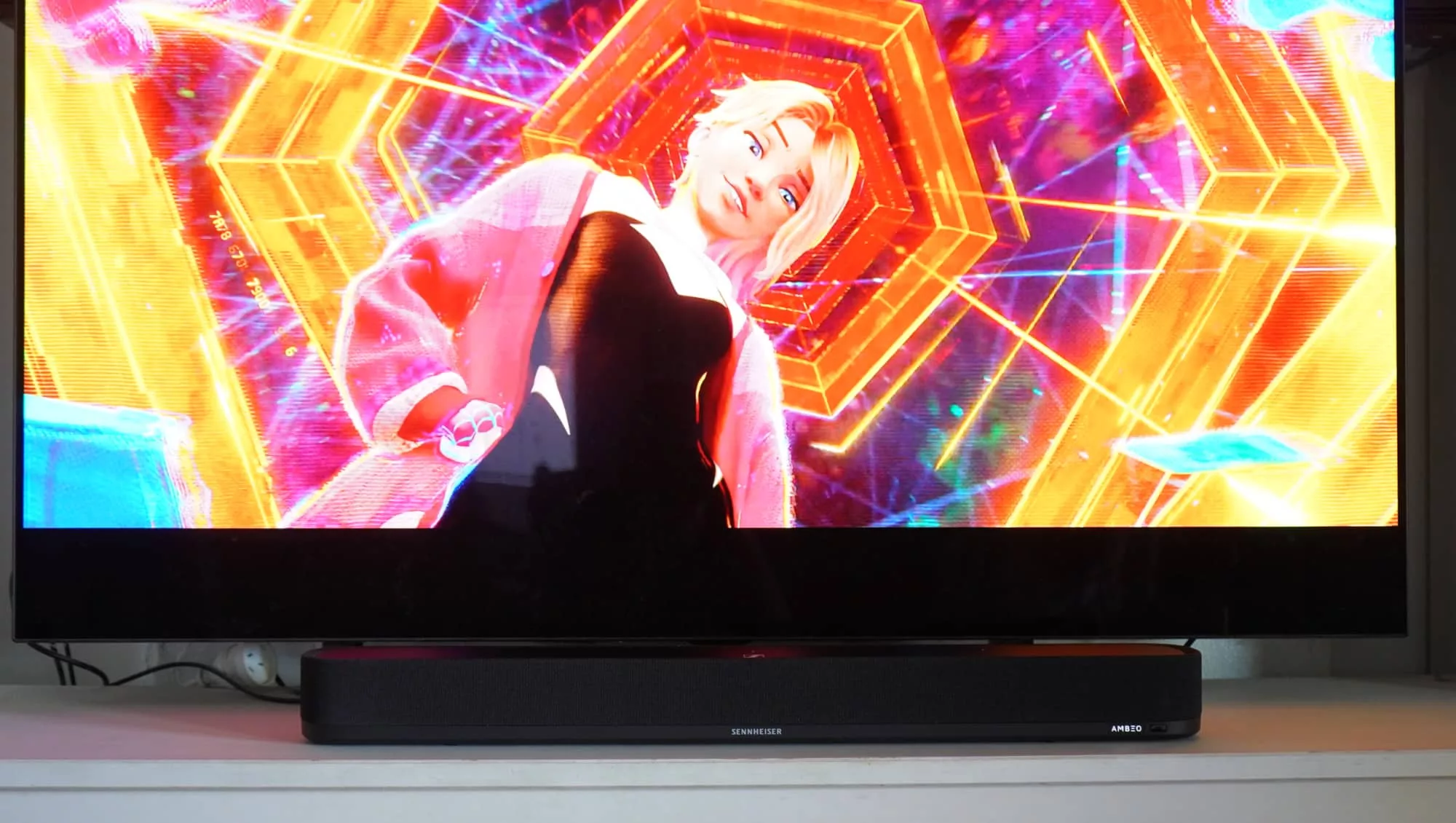
You definitely get that vibe during the knife-bullet fight in John Wick 4, where the sound effects for punches, kicks, and bullet casings are clear and distinct, but seem to lack some of the kick you might be looking for, ironic as that is.
Exploring the Ambeo Mini a little bit more, we jumped through scenes of Jurassic World, Mad Max: Fury Road, and Edge of Tomorrow, and were treated to some solid dimensionality, provided your head was faced forward. The timing of the system placed 3D sounds in enough places to trick your brain, and the result was exciting and fun, offering tiny explosions of bass where they needs to be.
And the delivery of live sound in both Whiplash and Bohemian Rhapsody was enough to give us the impression that both the intimate performance in the former and the large drawn out simulation of the live in the latter were equally real. The bass was a touch subdued, but the delivery was there.
Given the last two tests were on music, we had high hopes going into the next test.

Music
Unfortunately, the delivery was a little less impressive for music in the Ambeo Mini, and we’re fairly sure we’ve worked out why: the spatial support.
Sennheiser’s use of its “Ambeo” 3D sound settings may work lovely for movies, but in music it can feel like a restraint at times, forcing the bass to appear underhanded and mild by comparison.
For instance, when we listened to electronic from Tycho and Daft Punk in the Ambeo Mini’s spatial mode, you’ll find a surprisingly large stage with lots of detail, particularly in the highs, but the bass can feel absent. It’s almost as if you’re given a big room, and the bass has nowhere to land, with guttural bass totally absent.
It’s a similar feeling regardless of what we listened to:
- The punchy bass from Mark Ronson’s “Uptown Funk” sounded more structured and offered decidedly more punch with Ambeo mode off rather than on
- The sharp lows in Charlie Puth’s “Done For Me” were noticeable in Ambeo mode, but came to life more when it was switched off
- FKA Twigs’ “Two Weeks” sounded brighter and somewhat shallow when Ambeo’s spatial mode was switched on, with some of that strength returning when Ambeo was off
- The overwhelming warmth we look for in Muse’s “Madness” hardly overtook in either mode, but in Ambeo it felt deliberately restrained
Strangely, when you turn the Ambeo 3D upscaling off, the bass exists. It’s not the most impressive bass around that you get back, but the result is a lot better. It exists once again.
It’s pretty clear music and Ambeo 3D aren’t the best of friends in this soundbar, though fortunately you can turn that feature off.
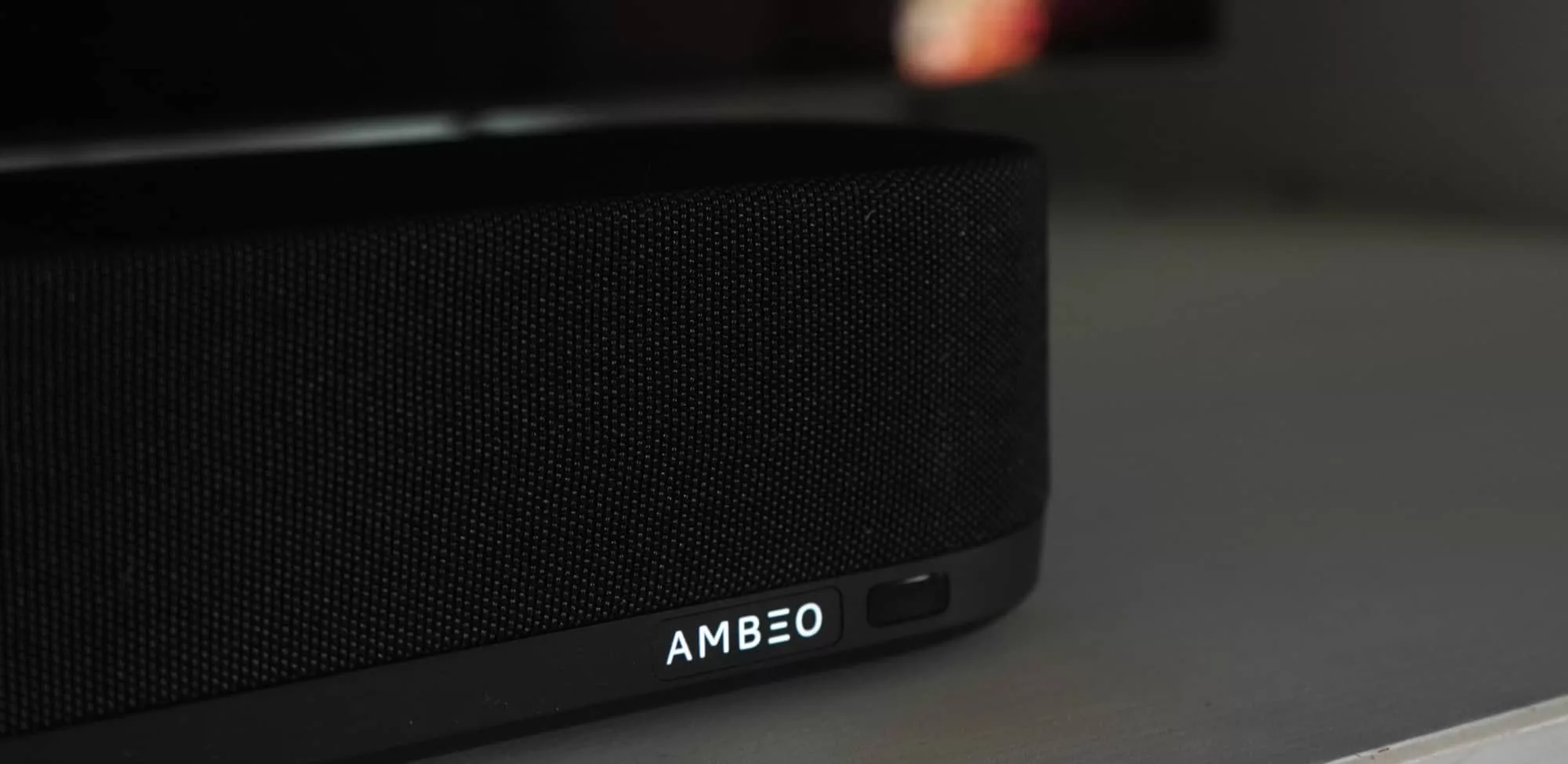
Value
Yet at $1299, it’s not easy to make the case for the Sennheiser Ambeo Mini. Sure, it’s less expensive than the four thousand dollar full-size Ambeo. That much is definitely true. But even at thirteen hundred dollars, we feel as though Sennheiser is punching above its weight.
For movies, there’s a reasonable amount of offer, and the system can clearly do some handy things.
We love that the Sennheiser soundbar app is the same app used for Sennheiser’s headphones. It’s a minor thing, but it means if you already use a pair of Momentum 4 or Momentum True Wireless 3 earphones, you can use the same app and interface with your soundbar, something Bose does with its app, as well.
And you don’t seem to need a special phone to trigger the room calibration, which works primarily from the soundbar itself and without the microphone accessory in the original $4K Ambeo soundbar. Rather, you just trigger the room calibration from the app, and the Ambeo Mini fires off a range of high, mid, and low sounds, measuring the time it takes for each sound to bounce on walls and ceiling in your home.
The problem is a lot of this stuff is becoming standard. Even in the Era 300 speakers, Sonos has basically geared a calibration test that’s compatible with more than just iPhones, triggering one that can dish out its calibration test TruePlay everywhere.
And that means neither of these features are necessarily worth extra in the Ambeo Mini. More just what you expect.
Unfortunately, you’re not getting that much more a premium experience than some other soundbars in its category. There aren’t any real upfiring speakers in the Ambeo Mini, and the sound quality isn’t a dramatic increase on its obvious major competitor in the Sonos Beam Gen 2, if there’s any at all.
The Beam Gen 2 costs $799 in Australia, while the Sennheiser Ambeo Mini is $1299. Even if you were paying for the Sennheiser name as an extra — and let’s face it, that can happen with brands — an increase of $500 isn’t really value. At the most, this is an $800 or $900 soundbar, which means the value here is difficult to account for.
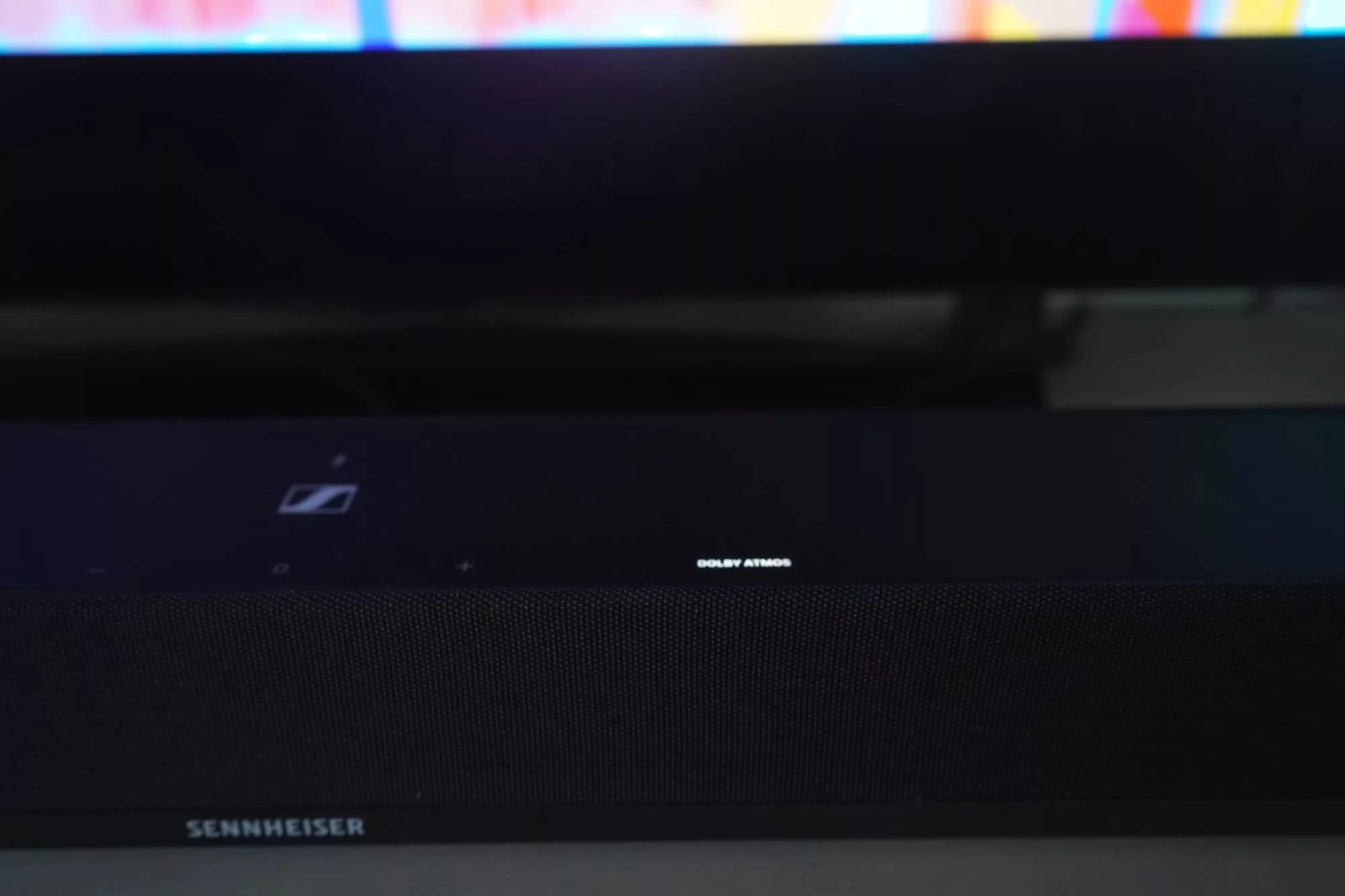
What needs work?
Not helping this is that your choice of upgrading the bass in the Ambeo Mini comes from the one subwoofer Sennheiser makes for the Ambeo line. Priced at $1199 in Australia, the aptly named Ambeo Sub is a sizeable addition to a home theatre using the Ambeo Mini, and one that you may want to hide under a chair, which is what we did.
Sennheiser supplied the Ambeo Sub for our review with the Ambeo Mini, but it does cost extra, and you basically need to spend the price of another Ambeo Mini to deliver better bass. That’s frustrating, and not helped when the bass itself feels restrained and underpowered, particularly in the spatial Ambeo mode.
We spent much of the review jumping in and out of the spatial mode Sennheiser offers because of the problems of bass.
For instance, when we turned off the Ambeo dimensionality, the bass improved, though it still felt like it was being squeezed to the point of not being there. When Ambeo was switched back on, listening for the boom and rumble in scenes didn’t deliver the desired effect. It was there, but it wasn’t the deep sound we expected, and certainly didn’t line up against what it competes with.
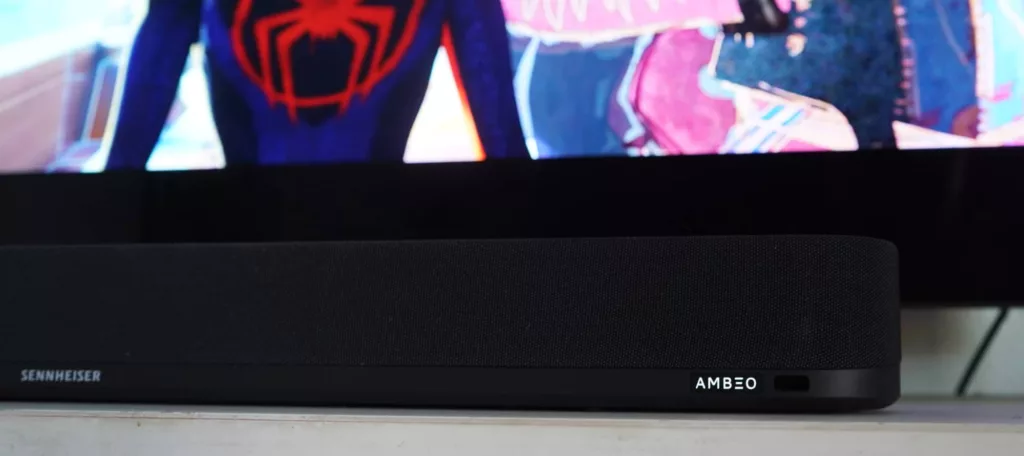
Sennheiser’s Ambeo Mini vs the competition
And the obvious competition Sennheiser is pushing the Ambeo Mini against is the Sonos Beam Gen 2, a lovely bit of small hardware that works on the same psychoacoustic simulated audio principle found in the Ambeo Mini, but seems to do a better job all the same.
It doesn’t help Sennheiser that there’s no way to obviously expand on what the Ambeo Mini delivers beyond using the subwoofer, while the Sonos Beam can add its own Sub Mini to the mix, and even a couple of rear speakers later on. In short, you can complete the sound of the Sonos Beam, but you’re a touch limited and restrained on the Ambeo, just like the sound of the bass.
For the price, the $1299 Ambeo Mini is also just way too high in Australia, competing directly with the $629 Beam Gen 2 and also the $1499 Sonos Arc, which may be a little more expensive, but is bigger and has more speakers inside. For $200 more, the Sonos Arc is more of a pure and proper spatial experience, featuring actual upfiring speakers, not just front speakers that use simulation to trick you.
Alternatively, there’s also the Bose Smart Soundbar 600, which is a mid-range option for $799 that featured upfiring speakers, or its bigger “Ultra” sibling for around twice the price. Both offer upfiring speakers as opposed to the virtual spatial audio, and so deliver that little bit more.
Seriously, the biggest problem with the Sennheiser Ambeo Mini is that price, which feels like you’re not getting a good deal at all.
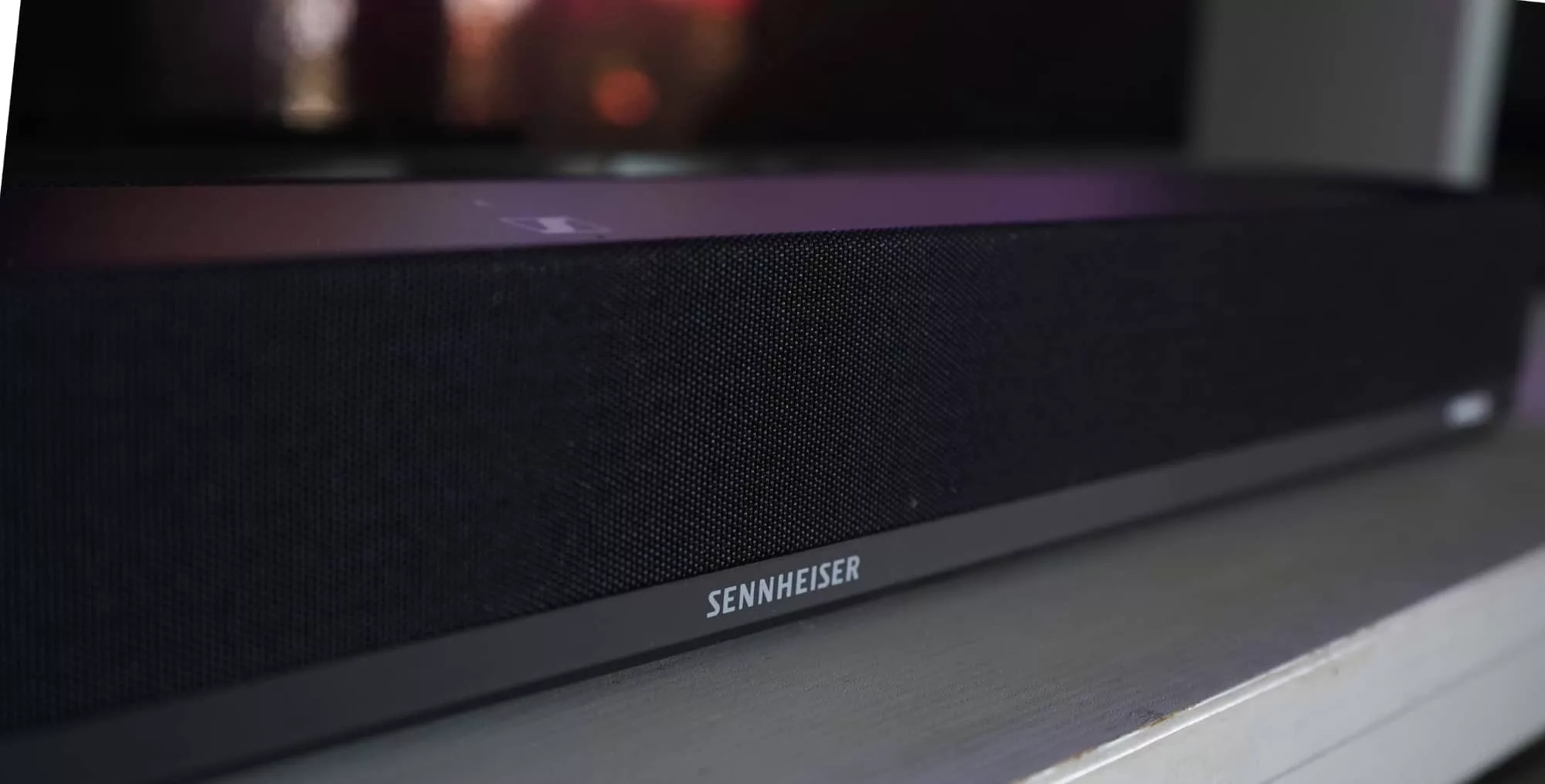
Final thoughts (TLDR)
Soundbar audio can vary wildly, and every brand making one is doing an approach that’s a little bit different, building for versatility, capability, or price.
Sennheiser doesn’t offer a lot of extra speakers to turn your Ambeo Mini into a full-fledged Ambeo system, so it’s not the versatility, while price is clearly not the drawcard in this model, either.
Capability is really what the Ambeo Mini is built for, and with the amount of volume it delivers, we get why. We’re just not sure we’re sold on the price. Over a thousand for psychoacoustic seems far too much for that, especially when rivals are delivering better interpretations for less or models with upfiring for less.
The brand may well come with the heritage to deliver great sound, but at this price tag, it’s playing to specific people, ideally those who love Sennheiser and already are enamoured with its gear. If that’s you, the Sennheiser Ambeo Mini is better for movies, less for music, but still packs a wallop.



